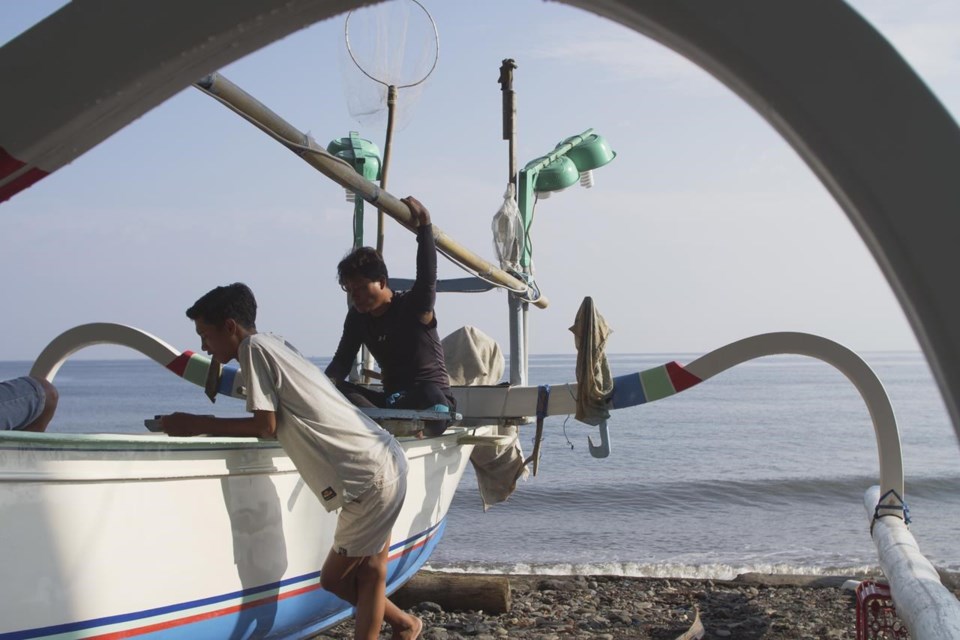LES, Indonesia (AP) — After diving into the warm sea off the coast of northern Bali, Indonesia, Made Partiana hovers above a bed of coral, holding his breath and scanning for flashes of movement. Hours later, exhausted, he returns to a rocky beach, towing plastic bags filled with his exquisite quarry: tropical fish of all shades and shapes.
Millions of saltwater fish like these are caught in Indonesia and other countries every year to fill aquariums in living rooms, waiting rooms and restaurants around the world with vivid, otherworldly life.
“It’s just so much fun to just watch the antics between different varieties of fish,” said Jack Siravo, a Rhode Island fish enthusiast.
But the journey from places like Bali to Rhode Island is perilous for the fish and the reefs they come from. Some are captured using squirts of cyanide to stun them. Many die along the way.
Even when captured carefully, by people like Partiana, experts say the global demand for these fish is contributing to the degradation of delicate coral ecosystems.
There have been efforts to reduce destructive practices, such as cyanide fishing. But the trade is difficult to regulate and track as it stretches from small scale fisherman in villages through middlemen, export warehouses, international trade hubs and finally to pet stores in the U.S., China, Europe and elsewhere.
“There’s no enforcement, no management, no data collection,” said Gayatri Reksodihardjo-Lilley, founder of LINI, a Bali-based nonprofit for the conservation and management of coastal marine resources.
That leaves some enthusiasts in the dark.
“Consumers often don’t know where their fish are coming from, and they don’t know how they are collected,” said Andrew Rhyne, a marine biology professor at Roger Williams University in Rhode Island.
Most ornamental saltwater fish species are caught in the wild because breeding them in captivity can be expensive, difficult and often impossible.
Nearly 3 million homes in the U.S. keep saltwater fish as pets, according to a 2021-2022 American Pet Products Association survey. About 7.6 million saltwater fish are imported into the U.S. every year. (Freshwater aquariums are far more common because freshwater fish are generally cheaper and easier to breed and care for.)
For decades, a common fishing technique has involved cyanide, with dire consequences for fish and marine ecosystems. Fishermen crush the pellets into a bottle filled with water. The diluted cyanide forms a poisonous mixture fishermen squirt onto coral reefs, where fish usually hide. The fish become temporarily stunned, allowing them to be picked from the coral.
Many die in transit, weakened by the cyanide – which means even more fish need to be captured to meet demand. The chemicals damage the living coral and make it difficult for new coral to grow.
Cyanide fishing has been banned in countries such as Indonesia and the Philippines but enforcement of the law remains difficult, and experts say the practice continues.
Part of the problem is geography, Reksodihardjo-Lilley explains. In the vast archipelago of Indonesia, there are about 34,000 miles (54,720 kilometers) of coastline across some 17,500 islands. That makes monitoring the first step of the supply chain difficult.
Another obstacle to monitoring and regulating of the trade is the quick pace that the fish can move between locations, making it difficult to trace their origins.
At a fish export warehouse in Denpasar, Bali, thousands of fish a day can be delivered in white Styrofoam coolers crammed with plastic bags of fish from around the archipelago. The fish are swiftly unpacked, sorted into tanks or new plastic bags and given fresh sea water.
Some fish will remain in small rectangular tanks in the warehouse for weeks, while others are shipped out quickly, fulfilling orders from the U.S., Europe and elsewhere. Once the fish fly from Indonesia to the U.S., they’re checked by the Fish and Wildlife Service, which cross-references the shipment with customs declaration forms.
But that’s designed to ensure no protected fish are being imported. The process cannot determine if the fish were caught legally.
Any fish caught using cyanide in a country where it’s prohibited would be illegal to import or sell in the U.S., thanks to a law called the Lacey Act. But no test exists to provide accurate results on whether a fish has been caught with cyanide, said Rhyne, the Roger Williams marine biology expert.
“The reality is that the Lacey Act isn’t used often because generally there’s no real record-keeping or way to enforce it,” said Rhyne.
In the absence of national enforcement, conservation groups and local fishermen have long been working to reduce cyanide fishing in places like Les, a saltwater aquarium fishing town in northern Bali.
Partiana started catching fish – using cyanide -- shortly after elementary school, when his parents could no longer afford to pay for his education. Every catch would help provide a few dollars of income for his family.
But over the years Partiana began to notice the reef was changing. “You could see there were less fish," he said.
He became part of a group of local fishermen who were taught by a local conservation organization how to use nets, care for the reef and patrol the area to guard against cyanide use.
Reksodihardjo-Lilley says it this type of local education and training that should be expanded to reduce harmful fishing. “People can see that they’re directly benefitting from the reefs being in good health.”
___
Associated Press video journalist Kathy Young reported from New York. Marshall Ritzel contributed to this report from Rhode Island.
___
Follow Victoria Milko on Twitter:
___
The Associated Press Health and Science Department receives support from the Howard Hughes Medical Institute’s Department of Science Education. The AP is solely responsible for all content.
Victoria Milko, Firdia Lisnawati And Kathy Young, The Associated Press




